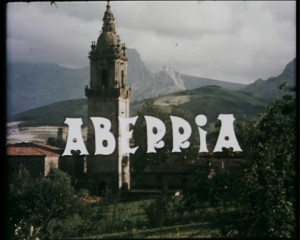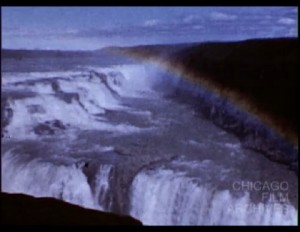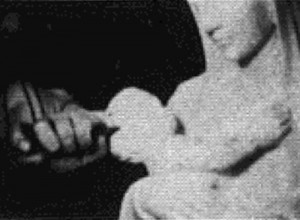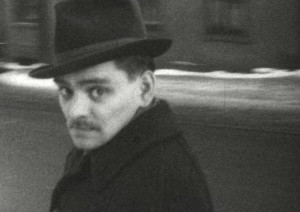"Design, by Walter Mills, ACL, is an expository film study on 8mm. and shows to fine advantages the possibilities of this medium for serious cinematic undertakings. In this 200 foot reel, the story of a day at the Kendall Art School, in Grand Rapids, Mich., has been told coherently and instructively. The picture represents real skill in planning, selection of viewpoint and photography. Naturally, most of the sequences in the film called for interior shots and the maker is to be commended highly for his lighting arrangements, which give perfectly normal effects in the film without the usual glare and unevenness. Angle shots and unusual camera positions are used with restraint but with most happy results when the situation calls for them. The technical quality is of uniform excellence and the cutting is done with particular care." Movie Makers, Dec. 1933, 522.
"For his excellent composition in the 650-foot 8mm. Kodachrome subject of "El Camino Real" John E. Walter, retiring vice president of the Los Angeles 8mm. Club, was awarded the f :1.8 20mm. Astro lens contributed by Mitchell Camera Corporation. The subject is a most interesting pictorial tour of the Pacific Coast missions, with intimate shots around each." American Cinematographer, Jan. 1938, 28.

Profunda reflexión sobre la Patria. Refleja la visión del ambiente rural de Euskal Herria a través de tomas de personajes populares como los bertsolaris Valentin Enbeitia y Jon Lopategi y el bailarín Victor Olaeta. Por razones de censura la película pasó a llamarse Erria (El Pueblo)
A profound reflection about the Homeland. Reflects the perspective of the rurality in Euskal Herria, through shots of popular characters such as the bertsolaris Valentin Enbetia and Jon Lopategi, and the dancer Victor Olaeta. Because of censorship, the name of the film had to be changed to Erria (The Town).
"Grandmother's Portrait is a documentary on the making of a modernistic, even abstract, metal "portrait" inspired by a photograph of the artist's grandmother. The artist doing the sawing and welding needed to construct the "portrait" is Kasperi Lofgren" PSA Journal, Sept. 1965, 50.
"doc. a fantasia"/avant-garde documentary

"Achieve new perspectives of Incredible Iceland as you travel with Robert Davis by plane, boat, jeep, and afoot. Exploring the many faces of this enchanting island." Lögberg-Heimskringla, Feb. 16, 1967, 8.

"The film opens in Florence, Italy, with the statue of David by Michelangelo, in marble. Then we quickly move to the quarry to observe the processes of opening a crack, part of the process of shearing off a piece from the huge mountain of marble. Later we see the cutting and slicing into useful slabs and polishing. Also, we visit a studio where, among other works, a large block of marble is being carved into a statue of Abraham Lincoln for the city of Boston. The commentary on tape is well done. This will be included in the Package" PSA Journal, Oct. 1962, 33.
"Stephen F. Voorhees's 400 ft. travel film of Italian architectural scenes deserves placement in this list because it combines three factors but rarely brought together in pictures of this type. First, the photography is extraordinarily good, not only with reference to the routine requirements of exposure and focus but because it is artistic throughout and the composition never descends to the casual or the "snap shot" level. Second, Mr. Voorhees's film has a natural and easy continuity, jogging amiably through Venice and its environs, much as a traveler might do himself, pausing for a bit of incidental human interest and catching a scene that the filmer felt was unusual but presenting it without any preliminary flourishes, as one friend who might have said to another in the course of a stroll, "Don't miss that, by the way," pointing to something seen on the way. Last of the three things, so unusual to find combined, is a professional study, made by the filmer, himself a great architect, preserving those details which he wished to bring from northern Italy for later possible use. The great Colleoni statue is studied from many angles. Details of tiles and other wall ornamentations are offered and buildings are presented from one viewpoint after another. Yet all of this is done unpedantically and the nonprofessional audience is not aware that this subtle architectural record is more than a delightful travel film." Movie Makers, Dec. 1931, 658.

C’est à l’automne 1937, au retour de l’exposition universelle de Paris, qu’Omer Parent entreprend la réalisation de l’œuvre expérimentale La vie d’Émile Lazo. En réaction directe à la « loi du cadenas » émise par le gouvernement Duplessis, le titre de ce court-métrage réfère au tout premier film visé par cette nouvelle motion censurogène, imposée aux médias : The life of Emile Zola de William Dieterle (1937).
S’il s’agit là du premier film expérimental achevé par Parent, l’œuvre est également issue d’une collaboration amicale au sein de professeurs de l’École des beaux-arts de Québec qui se prêtent au jeu de l’acteur : la sculptrice Sylvia d’Aoust (1902-2004), la dessinatrice Arline Généreux (1897-1987), la graveuse Simone Hudon (1905-1984), le couple Madeleine Des Rosiers (1904-1994) et son mari Jean Paul Lemieux (1904-1990), tous les deux peintres. À cette petite bande — qui fréquente l’éphémère atelier du « Nordet » où le tournage a lieu —, s’ajoute Robert Lapalme (1908-1997), caricaturiste et illustrateur de talent au style immédiatement reconnaissable, seule figure à ne pas occuper alors un poste de professeur. Sorte d’électron libre, Lapalme, en plus de rédiger le scénario du film en écho à sa propre existence, y incarne le rôle d’Émile Lazo. Terminé au printemps 1938, ce film « amateur » porte sur la condition de l’artiste « moderne » vis-à-vis de l’académisme dont il cherche à se libérer.
Peu après sa création, La vie d’Émile Lazo a été projetée à quelques reprises lors de présentations publiques et particulières dont une visait, en 1941, à célébrer l’installation d’Alfred Pellan — meilleur ami de Parent — dans son nouvel atelier. Depuis cette époque, ce film, dont il n’existe que deux copies sur pellicule, est demeuré pour ainsi dire inédit, connu seulement par quelques amateurs et spécialistes. Zoom-out est fier de présenter cette satire, rare et burlesque.
In the autumn of 1937, upon his return from the Paris Universal Exhibition, Omer Parent undertakes the creation of the experimental work "The Life of Emile Lazo". In direct reaction to the "Padlock Law" issued by the Duplessis government, the title of this short movie refers to the very first film targeted by this new censorship motion imposed on the media: William Dieterle's "The Life of Emile Zola" (1937). Completed in the spring of 1938, this "amateur" movie deals with the condition of the "modern" artist in relation to academicism from which he seeks to free himself.
While this is Parent's first experimental work, it is also the result of a friendly collaboration among professors at the École des beaux-arts de Québec who lend themselves to the role of actors: sculptor Sylvia d'Aoust (1902-2004), draughtswoman Arline Généreux (1897-1987), engraver Simone Hudon (1905-1984), the couple Madeleine Des Rosiers (1904-1994) and her husband Jean Paul Lemieux (1904-1990), both painters. A little appart in this small group of artists and professors — who frequents the ephemeral "Nordet" studio where filming takes place— Robert Lapalme (1908-1997), a talented caricaturist and illustrator with a immediately recognizable style, is added. Lapalme, in addition to writing the film's screenplay in echo with his own existence, also plays the role of Émile Lazo.
Shortly after its creation, "The Life of Émile Lazo" was screened a few times during public and private presentations, one of which aimed, in 1941, to celebrate the installation of Alfred Pellan—Parent's best friend—in his new studio. Since then, this rare and burlesque satire, of which only two copies on film exist, has remained virtually unpublished, known only to a few enthusiasts and specialists until fall of 2022 where it was realeased online.
Total Pages: 8